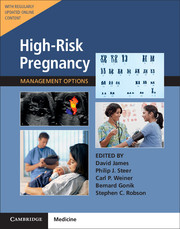Book contents
- Frontmatter
- Contents
- List of Contributors
- Preface
- Section 1 Prepregnancy Problems
- Section 2 Early Prenatal Problems
- Section 3 Late Prenatal – Fetal Problems
- Section 4 Problems Associated with Infection
- Section 5 Late Pregnancy – Maternal Problems
- 30 Substance Misuse in Pregnancy
- 31 Medication in Pregnancy
- 32 Hypertension in Pregnancy
- 33 Cardiac Disease in Pregnancy
- 34 Respiratory Disease in Pregnancy
- 35 Anemia and White Blood Cell Disorders in Pregnancy
- 36 Hematological Malignancies in Pregnancy
- 37 Thrombocytopenia and Bleeding Disorders in Pregnancy
- 38 Disorders of Coagulation in Pregnancy
- 39 Autoimmune Disease in Pregnancy
- 40 Diabetes in Pregnancy
- 41 Thyroid Disease in Pregnancy
- 42 Pituitary and Adrenal Disease in Pregnancy
- 43 Gastrointestinal and Liver Diseases in Pregnancy
- 44 Neurologic Complications in Pregnancy
- 45 Renal Disorders in Pregnancy
- 46 Spine and Joint Disorders in Pregnancy
- 47 Skin Disease in Pregnancy
- 48 Malignant Disease in Pregnancy
- 49 Pregnancy After Transplantation
- 50 Trauma in Pregnancy
- 51 Mental Health Disorders in Pregnancy
- Section 6 Late Prenatal – Obstetric Problems
- Section 7 Postnatal Problems
- Section 8 Normal Values
- Index
39 - Autoimmune Disease in Pregnancy
from Section 5 - Late Pregnancy – Maternal Problems
- Frontmatter
- Contents
- List of Contributors
- Preface
- Section 1 Prepregnancy Problems
- Section 2 Early Prenatal Problems
- Section 3 Late Prenatal – Fetal Problems
- Section 4 Problems Associated with Infection
- Section 5 Late Pregnancy – Maternal Problems
- 30 Substance Misuse in Pregnancy
- 31 Medication in Pregnancy
- 32 Hypertension in Pregnancy
- 33 Cardiac Disease in Pregnancy
- 34 Respiratory Disease in Pregnancy
- 35 Anemia and White Blood Cell Disorders in Pregnancy
- 36 Hematological Malignancies in Pregnancy
- 37 Thrombocytopenia and Bleeding Disorders in Pregnancy
- 38 Disorders of Coagulation in Pregnancy
- 39 Autoimmune Disease in Pregnancy
- 40 Diabetes in Pregnancy
- 41 Thyroid Disease in Pregnancy
- 42 Pituitary and Adrenal Disease in Pregnancy
- 43 Gastrointestinal and Liver Diseases in Pregnancy
- 44 Neurologic Complications in Pregnancy
- 45 Renal Disorders in Pregnancy
- 46 Spine and Joint Disorders in Pregnancy
- 47 Skin Disease in Pregnancy
- 48 Malignant Disease in Pregnancy
- 49 Pregnancy After Transplantation
- 50 Trauma in Pregnancy
- 51 Mental Health Disorders in Pregnancy
- Section 6 Late Prenatal – Obstetric Problems
- Section 7 Postnatal Problems
- Section 8 Normal Values
- Index
Summary
Introduction
The immune system's remarkable ability to protect the body from invasion by foreign pathogens stems from its capacity to distinguish biologic “self” from “nonself.” An aberration in this normally wellregulated process leads to so-called autoimmunity, in which immune effector cells are directed against “self” tissues. Persistent abnormal immunologic activation results in autoimmune disease, each type characterized by a typical pattern of clinical signs and symptoms and confirmed by the presence of immune effector cells, usually autoantibodies. In some autoimmune conditions, serologically detected autoantibodies play an active role in tissue damage, while in others they serve only to confirm the existence of an autoimmune process. The pathophysiology leading to autoimmunity likely involves a failure of complex regulatory mechanisms, which normally control activation and deactivation of the immune system. Recent investigations suggest that full expression of autoimmune disease depends on a combination of environmental, genetic, and host factors. Autoimmune diseases have a predilection for reproductive-age women and are frequently encountered during pregnancy. More than 70% of patients with autoimmune disease are women of reproductive age. Both animal models and human studies support the role of sex hormones in the development of autoimmunity. Estrogens appear to accelerate disease, while androgens are protective.1–4 Not surprisingly, pregnancy-associated fluctuations in sex hormones may influence disease severity. Diseases with strong cellular pathophysiology, such as rheumatoid arthritis (RA) and multiple sclerosis, tend to improve during pregnancy, whereas those characterized by autoantibody production, such as systemic lupus erythematosus (SLE) and Graves’ disease, increase in severity. Still others are unique to pregnancy or have unique features associated with pregnancy.
Immunosuppressive Agents During Pregnancy
It is often necessary to continue immunosuppressive agents during pregnancy in women with preexisting autoimmune disease. Some of the most frequently prescribed immunosuppressive agents may be used safely during pregnancy while others are strictly contraindicated (Table 39.1). Still others have not been studied sufficiently during pregnancy. As with any drug during pregnancy, the goal of autoimmune treatment is to adequately control disease activity without placing undue risk on the mother and fetus. The decision to use any immunosuppressive agent during pregnancy should be based on the clinical context, risks associated with individual medications, and the stage of pregnancy.
- Type
- Chapter
- Information
- High-Risk Pregnancy: Management OptionsFive-Year Institutional Subscription with Online Updates, pp. 1108 - 1159Publisher: Cambridge University PressFirst published in: 2017



